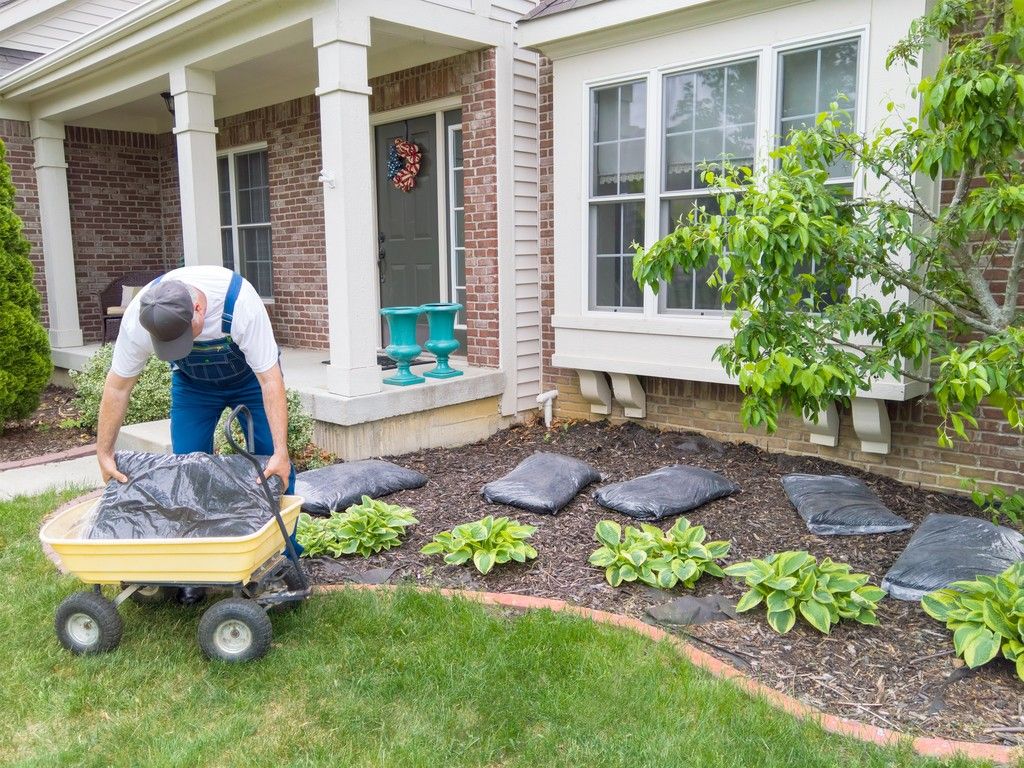6 Ways to Make Your Lawn Maintenance-Free

If you’re like many Americans, you may find that tending to your lawn can be a deeply rewarding experience. In fact, regularly mowing your grass can improve your physical health, boost your mood, and strengthen your connection with neighbors. However, if your lawn requires perpetual maintenance, it can transform a hobby you love into an obligation you dread. Those many hours spent cutting grass or pulling weeds under a glaring sun can quickly become a chore you’d eagerly avoid.
The good news? Lawn care and landscaping experts say there are several ways you can lower the workload of your lawn so that you can focus more on the aspects of gardening you enjoy. Read on to learn six ways to make your lawn close to maintenance-free, for great-looking greenery with a fraction of the effort.
RELATED: 18 Mistakes That Are Destroying Your Garden.
1
Install an automated watering system.

Watering your lawn can take up a surprising amount of time, especially if your property includes ample acreage. An automated irrigation system can take this job right off your plate.
“Automated irrigation systems, such as drip irrigation or sprinklers with timers, ensure that your lawn receives the right amount of water at the optimal time,” says Robert Martinez, an author at the website Yardenz, which specializes in landscaping and lawn care. “This promotes water efficiency, reduces water wastage, and prevents over or under-watering, ultimately leading to a healthier lawn.”
2
Plant drought-tolerant grass.

Another way to spend less time watering your lawn is to gradually re-seed with drought-tolerant grass, says Gene Caballero, a landscaper and the co-founder of GreenPal. “Some grass types, such as Bermuda or Zoysia, require less water and are more resistant to pests and diseases.”
Watering deeply but infrequently, and maintaining healthy soil, can also help to make any grass type more drought-resistant over time.
RELATED: 6 Ways to Pest-Proof Your Grass, According to Landscaping Experts.
3
Choose your plants carefully.

Just as you should choose your grass type with care, you should also be thoughtful as you select any additional plants on your lawn’s periphery.
“Incorporate a variety of perennial plants into your lawn landscape,” suggests Martinez. “Perennials come back year after year, eliminating the need for constant replanting. They are often hardy and require less maintenance, allowing you to enjoy a beautiful garden without the hassle of seasonal planting.”
Martinez adds that selecting plants native to your region and those adapted to local climate conditions will help ensure they are better equipped to withstand environmental challenges. “Drought-resistant plants are particularly valuable, demanding less water and care while thriving in your area.”
4
Use mulch for weed control.

Investing a bit of time upfront to lay down mulch will also save you time and maintenance in the long run by helping to control weeds.
“Mulching around plants and garden beds helps suppress weed growth by blocking sunlight and reducing soil moisture evaporation,” Martinez tells Best Life. “Organic mulches, like wood chips or compost, enrich the soil as they break down, benefiting your plants and reducing the need for frequent weeding.”
As long as it’s not concentrated in clumps—which can kill your healthy grass underneath—you can also use your grass clippings as mulch after mowing to act as a natural fertilizer. “It saves time on disposal and reduces the need for additional fertilization,” Martinez notes.
For more home and gardening tips sent directly to your inbox, sign up for our daily newsletter.
5
Mow taller and less frequently.

According to the Chicago Tribune, the average American spends over 70 hours per year mowing their lawn. However, changing your habits when you mow can translate into less time spent on your lawn care routine.
“Raise the cutting height of your lawn mower to allow grass to grow taller,” suggests Martinez. “Taller grass shades the soil, promoting root growth and preventing weed establishment. Additionally, mowing less frequently reduces stress on the grass, leading to a healthier and low-maintenance lawn.”
6
Practice organic lawn care.

By practicing organic lawn care, you can cut down significantly on your total time spent maintaining your grass.
“This includes composting, using organic fertilizers, and encouraging beneficial insects and microorganisms,” Caballero says. “Over time, this will build healthy, resilient soil that can fend off pests and diseases with minimal intervention.”
However, he notes that while there are many ways to cut down on your lawn care with low-maintenance features, this doesn’t mean you should completely neglect your grass. Instead, focus on automating the time-sucking tasks so you can focus more on the finishing touches that make your lawn the pride of your property.